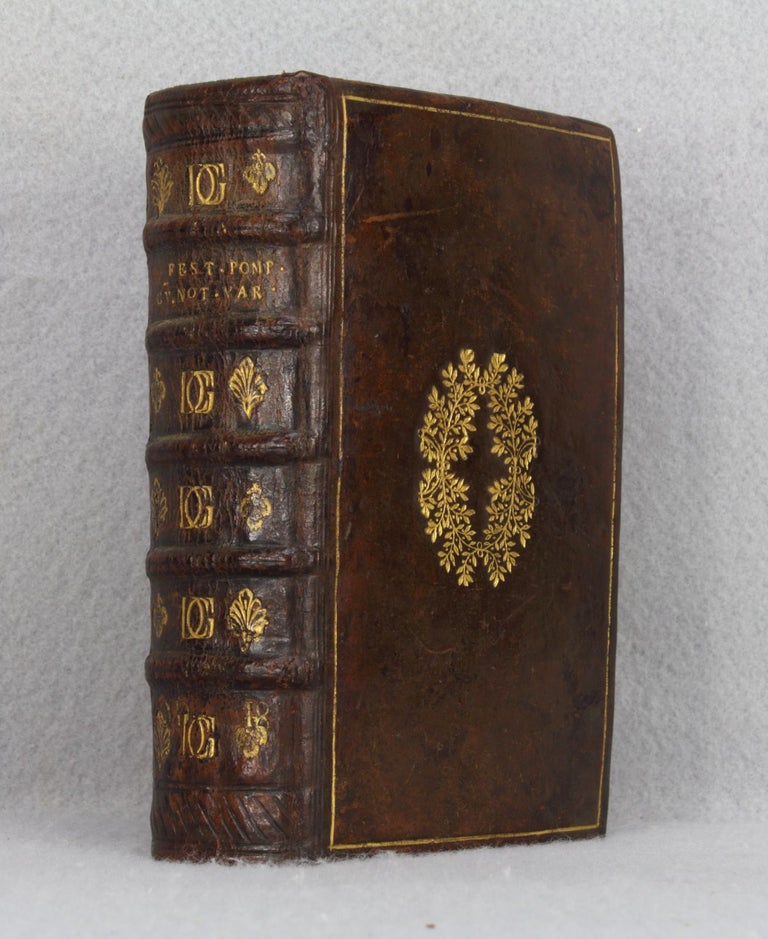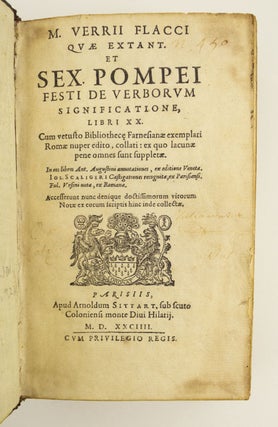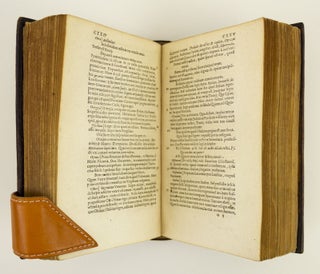M. VERRII FLACCI QUÆ EXTANT. ET SEX. POMPEI FESTI DE VERBORUM SIGNIFICATIONE.
(Paris: Arnold Sittart, 1584; [Heidelberg]: Peter Santandrea, 1583). 178 x 111 mm. (7 x 4 3/8"). 14 p.l., cccix pp., [13] leaves (last blank); lxxv, [10], ccxvi, [22] pp.; [2] leaves, 84 pp.; [1], 1-196, [18] pp.; 62 pp. Two works, in several parts, bound in one volume. With annotations and commentary by Antonio Augustin, Joseph Scaliger, and Fulvio Orsini.
Pleasing contemporary calf, covers with central gilt wreath of olive branches, raised bands, spine panels gilt with cipher "D C G" at center flanked by a palmette and a vegetal trefoil, gilt titling, bottom panel with "OD" and "I8" on either side of the cipher. Printers' devices on the title pages, decorative woodcut initials and headpieces. Front pastedown with what appear to be early library shelf markings; one page with neat early marginalia. Adams V-590 and F-390. ◆Covers slightly marked, spine with a bit of superficial crackling (and with one short crack in the middle of bottom panel), the text with faint browning and isolated minor soiling, a few leaves with long, shallow creases (not affecting legibility), otherwise in excellent condition, the binding solid and without significant wear, and the leaves generally clean, fresh, and smooth.
This glossary of recondite Latin words and phrases was no doubt bound for a contemporary bibliophile with an extensive library. The "OD" and "I8" at the bottom of the spine appear to be the indication of a shelf location--not something frequently encountered on spines of this period. This designation and the location notation on the front pastedown that clearly relates to it ("Arm. 0. Tab 4. Loc. 18") suggest a library of some complexity and an educated owner who believed in careful organization. While we have not been able to identify "D C G," (s)he would seem also to have been a person of taste and good sense. The binding is attractively decorated while still being practical for scholarly use. The work itself has gone through a number of changes of fortune. The story begins when Verrius, who lived in the time of Augustus, compiled a valuable work, full of information on everything from grammar to mythology. Unfortunately, his text has been largely lost; the authentic fragments fill only the first few leaves of our volume. His work was epitomized by Festus, a ca. third century scholar, but Festus was not a very good epitomizer and, to make matters worse, all of his entries have been lost up to the letter "M." Luckily, an epitome of the epitome from "A" to "Z" had been made by Paul the Deacon in the eighth century. Valuing the handbook for its information on the writing of correct Latin, Renaissance scholars went to work on this puzzle in the 15th century, and a first version of Paul was published by Zarotus in Milan in 1471. Later scholars published Festus, and the great French classicist Joseph Scaliger (1540-1609) was largely responsible for bringing definitive order out of chaos. His scholarly edition reconstructs the work of Festus as far as one can, filling in the gaps caused by missing pages in the manuscript with conjectures and rectified material from Paul. (ST15026)
Price: $2,500.00




